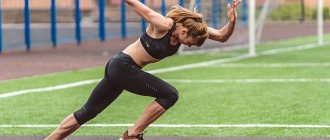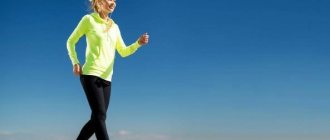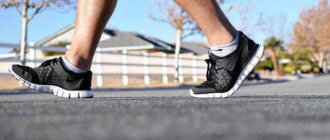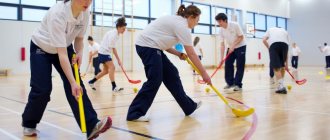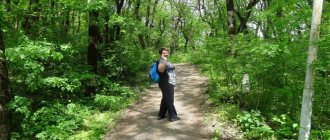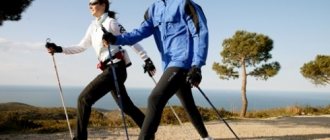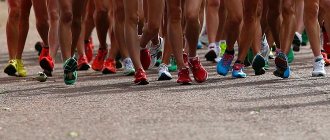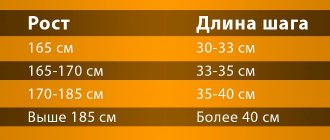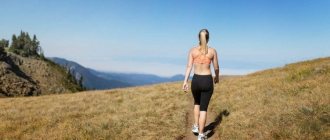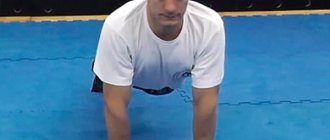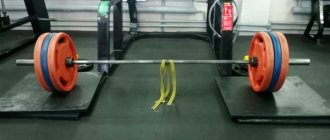Hello, dear readers! I’m with you on this page, Albert! Today, physical inactivity is considered the enemy of modern humanity.
And the easiest way to combat it is walking. This affordable physical activity helps you lose excess weight, relieve fatigue after a hard day, increase endurance and immunity.
Otherwise, insufficient physical activity, which provides people with the functioning of all muscle, joint and bone structures, can provoke the development of serious pathological processes in them. For example, in men with age - heart failure, and in women after menopause - osteoporosis.
Moreover, if a person wants to be healthy, he must constantly actively regulate his motor function. However, this option is purely individual.
After all, the average speed of a person when walking, running or skiing differs significantly. Therefore, I want to introduce you to these values, within what limits they fluctuate and how they are related to the state of human health.
general information
Race walking is one of the disciplines in athletics. It has certain features of simple walking, but is distinguished by its productivity, technical complexity and lower energy consumption.
The first competitions of athletes in this sport were held in 1882 in London, and in 1932 race walking became part of the Olympic disciplines in athletics. In the competition, the men's distance is 50 km, the women's - 20 km.
A distinctive feature of the competition is that the athletes are controlled by judges throughout the entire distance. The number of judges is from 6 to 9, they hold two yellow spatulas (flags) in their hands and analyze the technique of each participant. A wavy line is drawn on one of the shoulder blades, it indicates that the athlete has come off the surface or has lost contact with the ground, on the second shoulder blade there are 2 lines at an angle of 150 degrees - it signals that the supporting leg, which was brought forward, was bent at the knees . After warning the athlete, the judge sends a red card to the head judge, after receiving 3 red cards from different judges, the participant is disqualified. The chief judge has the right to disqualify an athlete in the last sections of the distance. At the Olympics or World Championships, the execution technique can only be violated once.
The benefits of race walking
As everyone knows, life is movement, so it is obvious to everyone that race walking is healthier than sitting or lying down. However, what is the benefit or advantage of this activity relative to other sports. So, let's figure out the benefits of race walking:
- This sport is easily accessible to most - all you need is the desire to go for a walk, comfortable sports shoes and clothing. It follows from this that this activity will not bring you additional costs.
- Gentle stress on joints (especially knees) and spine, unlike running. This is especially true for overweight people, because running is strictly prohibited for them due to the destructive effect on the joints.
- Walking is more natural for a person, without creating a feeling of violence against the body.
- This sports activity does not create such an intense load on the heart and blood vessels, which occurs when running long distances, i.e. walking does not cause hypertrophic changes in the heart muscle (“athletic heart effect”).
- Strengthens the entire immune system, increases a person’s resistance to various unfavorable factors - high and low temperatures, lack of oxygen, and even reduces the risk of developing cancer.
- Normalizes the functions of the central nervous system - in our time, stress has become an integral part of human life, because of it, sleep is disturbed, appetite disappears, apathy and depression develop. It perfectly functions as an antidepressant. In severe shocks, a person simply needs to walk a lot and for a long time to calm down.
Average speed of a person when walking
Hello, dear readers! I’m with you on this page, Albert! Today, physical inactivity is considered the enemy of modern humanity.
And the easiest way to combat it is walking. This affordable physical activity helps you lose excess weight, relieve fatigue after a hard day, increase endurance and immunity.
Otherwise, insufficient physical activity, which provides people with the functioning of all muscle, joint and bone structures, can provoke the development of serious pathological processes in them. For example, in men with age - heart failure, and in women after menopause - osteoporosis.
Moreover, if a person wants to be healthy, he must constantly actively regulate his motor function. However, this option is purely individual.
After all, the average speed of a person when walking, running or skiing differs significantly. Therefore, I want to introduce you to these values, within what limits they fluctuate and how they are related to the state of human health.
Rules and techniques of race walking
The basic rules of race walking are “steady step” and “not bent, walking leg.” In order to understand this, you need to understand the basics of race walking techniques. As in regular and race walking, the step technique is based on alternating one and two supports.
One support is when a person leans on one leg (it is completely straight and has a vertical position) and the second leg is extended in order to take a step. It should be in a bent position and the hip should go forward and up, while the supporting leg remains straight, but in an inclined position.
The next stage is two supports, at the moment when the walking leg straightens and places the heel on the surface, the supporting leg still rests its toe on the surface. This phase lasts for hundredths of a second and will decrease as speed increases. After a moment, the athlete leans on one leg extended forward.
The last stage - the “former” supporting leg becomes the fly leg, it is carried forward, the foot is not high above the ground, it moves forward with the thigh up and the thigh, having reached a certain height, begins to fall and at the same time the lower leg moves forward, the heel touches the ground, at this moment the leg becomes absolutely straight and the swing leg becomes the supporting leg again.
The athlete's torso should be in an upright position or he can lean forward slightly; a strong torso tilt can lead to a greater chance of running. During race walking, due to rotation of the shoulders and pelvis in different directions, a slight twisting of the torso occurs.
The race walking technique is based on the absence of a flight phase (this is when both legs lift off the ground). This phase exists only in running, and when walking quickly, a person begins to use it unnoticed, to avoid speed when pushing off, do not use the “quadriceps hip extensor” - this is the strongest muscle of the thigh. In addition, the walker is helped to walk “correctly” by the movements of the pelvis - around the vertical axis forward and backward.
What is the difference between race walking and regular walking?
If you look at how professional athletes and ordinary people walk, the difference in walking style is obvious.
So, the main differences between race walking and regular walking:
- High speed - athletes walk 3 times faster than ordinary people, their average speed is 14 - 16 km/h or up to 210 steps per minute.
- The step length is from 70 to 85 cm for a normal walk, from 100 to 120 cm for a professional walker.
- High intensity of movements - a very large number of steps, but the athlete does not start running. The average time spent on one step is 0.3 seconds.
- Vigorous vertical rotation of the pelvis, and bent arms move forward and backward.
- Unlike the usual walking method, the leg, at the moment the heel touches the ground until the moment when it becomes a supporting leg, is always in a straightened position and bends only before it needs to be raised.
Walking. Its benefits for the body. Average speed of a person when walking and running
All parents eagerly wait for their baby to take the first step. And for a child, independent walking is a sea of new opportunities. But as we become adults, we begin to forget how much the ability to move freely in space has brought into our lives.
As children, we walked slowly and carefully. Over time, the steps become more confident, and the average speed of a person increases. Walking on foot is as natural for an adult as breathing.
Types of walking
Race walking is one of the types of walking. In addition, the following forms of this activity are distinguished:
- Nordic walking - its distinctive feature is the use of poles.
- Walking uphill or on hilly terrain.
- Walking for weight loss.
In addition, you can divide walking by speed:
- For walking – up to 4 km per hour, does not have any special health-improving effect.
- Accelerated or recreational - up to 7 km per hour, this is an intermediate stage between recreational and professional sports. Regular exercise helps achieve all the health goals of walking - lower blood pressure, lose excess weight, etc.
- Sports – up to 15 km per hour. It is intended for professional athletes.
Walking on hilly terrain
To denote this type of race walking, the following concepts are used: trekking, hiking and backpacking. They have nothing to do with sports, rather they are related to tourism and hiking in the mountains. The difference between these terms is the duration of the route and the equipment used.
If we talk about constant walks in the mountains, their usefulness lies in the fact that climbing a mountain is an excellent prevention of strokes and heart attacks. Proof of this fact is a small town in Switzerland (Blattendorf), access to which by road is limited due to the steep mountainous terrain around it, so its residents are forced to walk most of their lives. Despite these inconveniences, one interesting phenomenon is observed in this city - the population practically does not experience myocardial infarction, although the statistics for other cities in Switzerland are very deplorable.
It is not worth recommending that beginners start their hiking in mountainous areas, but it is obvious that they are more effective than walking on a flat surface. Mountain lovers point out one interesting feature - it’s easier to go up than to go down.
Walking on level ground
Walking on level terrain is typical for most people. The fact is that city residents rarely go to the mountains, and not all countries can boast of having them. In the city, it is very important to choose “natural” places for walks - parks, forests, walking areas, and avoid paths along polluted highways.
In the technique of sports recreational walking, it is important to observe the following point - when placing the foot on the ground (asphalt), the edge of the heel should not rest against the surface, as happens in running. Landing should occur on the middle part of the heel, then a soft roll to the toe should occur. In addition, if you have clubfoot or a tendency to turn your foot, then you need to eliminate this, otherwise long and constant exercise will only aggravate the problem and lead to joint injury.
How fast can children walk
Walking has the most positive effect on a growing child's body. Children often walk slower than adults. As was said, the average speed of a person when walking depends on the width of the step, and this is directly determined by the length of the legs. As the child grows, the speed of walking and running increases accordingly. The average speed of children is approximately as follows:
• A child of two years can walk at an average speed of two kilometers per hour. Its maximum speed exceeds 3 km/h.
• A four-year-old child can already reach walking speeds of up to 4 km/h.
• Children who have reached the age of five or six walk at a speed of four to five kilometers per hour.
Rules of race walking for weight loss
You can engage in race walking for health purposes, one of these goals is weight loss. Race walking for weight loss is a solution for overweight people, because other sports activities can pose a threat to their joints, heart, blood pressure and blood vessels.
How to walk correctly to lose weight?
- The rule is 10,000 steps a day - it is believed that for a slim figure you need to walk at least this figure. In order to track this, you can buy a pedometer device.
- Slow start, gradual increase in tempo and slow end. This gentle regime will help you avoid unnecessary stress.
- You need to set yourself a goal: after a certain time (a month, six months or a year), walk 6 - 7 km per hour.
- You should start with 20 minutes of continuous walking a day, i.e. You cannot plan visits to stores, etc. Just walk for 20 minutes, gradually this time should increase to 40-60 minutes.
- In losing weight, it is important to understand that training solves only 20 to 50% of the problem, the rest depends on your food. If after classes you still indulge yourself with fast food and other “junk” foods, then you cannot hope for much progress in the fight against excess weight.
- Eating should be done 2 hours before training, walking is an energy-consuming activity, so a person will often feel hungry, which can be satisfied 1-2 hours after the end of the training.
- It is important to drink plenty of fluids and not deny yourself quenching your thirst.
- According to reviews, walking with poles (Scandinavian) is more effective in terms of weight loss.
It is interesting to note that while walking, complex fats are consumed, not carbohydrates.
In order for the muscles to do the work, they must be provided with nutrition by fats and carbohydrates, but carbohydrates are broken down more easily than fats and less oxygen is needed for their oxidation, therefore, during intense exercise (running), it is carbohydrates that provide nutrition to the muscles, but during low-intensity exercise they begin to It is the fats that are broken down.
In this case, walking at a pace of up to 7 km per hour is even more effective for people suffering from excess weight than fast running.
What is the average running speed of a person
Often people who want to lose weight and keep their body in shape take up running. For a modern person, running is not just a sport, but also a “remedy for being late.” As children, we ran to be on time for class; in adulthood, sometimes we have to run to get to work on time. In such situations, when there are only a few minutes left before an important event, and we can only rely on our legs, we ask the question: “What is the average running speed of a person?” Naturally, this depends on the preparedness and endurance of the body.
Athletes are able to reach speeds of 40-45 km/h. Of course, running at this pace cannot last long. Long course runners distribute their energy so that they can run as fast as possible for a long time. In this case, this figure is 14-15 km/h.
If we are not talking about an athlete, then his running speed is twice as fast as the average speed of a person when walking and is approximately 9 km/h. Regular jogging has a beneficial effect on the general condition of the body and tones the muscles. And if such training is carried out in the fresh air, the benefits are double.
How to warm up properly
In order to reduce the likelihood of a sports injury, it is imperative to warm up before training or competition.
Regular exercises, which most people remember from physical education lessons, help warm up muscles and joints. It should take 7-10 minutes and may include the following exercises:
- Warming up the joints - tilting and turning the head, rotating the shoulders, arms, pelvis, legs and feet.
- Raising your arms in front of you, bending your torso to the side or towards your legs, lunging to the side and forward, squats.
- Jumping or running in place, running with knees raised.
- At the end, you need to restore your breathing using inhalation or exhalation exercises.
Load calculation
For any sports activity, it is necessary to choose the right load. This is done in order to eliminate the low effectiveness of classes and at the same time not to overload your body.
To calculate any sports load, it is important to know the heart rate (HR), or simply the pulse rate of a person at rest, and it is also necessary to take into account the level of his physical fitness.
For a person without sports training, the maximum possible heart rate (HR max) is calculated using the formula: 180 – the person’s age, i.e. for a 40-year-old person, the maximum possible heart rate is 140 beats per minute; you should not “go beyond” this limit, because instead of strengthening the heart, it will be destroyed.
For more prepared people (former athletes), the formula for the maximum possible heart rate will differ in the first digit: 190 - the person’s age. The differences in the formula are explained by the fact that a trained person has a higher anaerobic metabolic threshold (ATT) than an ordinary person.
PANO is an indicator beyond which the body begins to experience a lack of oxygen and produce lactic acid. With age, the body weakens and exceeding this indicator threatens to cause serious complications in the form of a heart attack, heart attack, etc. The safety of training directly depends on whether the TANO level is exceeded.
It is necessary to calculate the load at the beginning of training, then you yourself must “find” the walking pace that is suitable for you, which will bring you benefit and joy. It is important to experience pleasure from such activities; it should not bring you a feeling of excessive burden.
In order to determine your pace, it is important to walk alone at first, because often a companion will have his own speed, which will throw you off and will not bring you any benefit.
It is important to maintain regularity - at the first stage, 3-4 workouts per week for 30 minutes of walking without stopping will be enough, after a couple of months the time should increase to 40-60 minutes. Ideally, 5 lessons per week, 1 hour each.
How many calories can walking burn?
Walking is not the most energy-intensive sport; in terms of the number of calories burned, it is significantly inferior to other types of training. This should not become an obstacle for those who want to lose weight by walking, and without strain and exhausting exercises.
This is interesting: the fat-burning effect of walking can be greatly enhanced. To do this, you need to wake up a little earlier in the morning, eat nothing, drink enough water ( never drink tea or coffee with sugar ), get dressed and go for an energetic walk for 30 minutes.
During such walking on an empty stomach, the body will burn a large amount of fat because it is in a state of hunger. In 8-10 hours of sleep at night, our body manages to use up almost all its reserves of the energy substance glycogen and is therefore forced to burn fat to produce energy. It is important to remember that the larger and larger a person is, the more calories he spends in principle. For example, a person weighing 70 kg will lose 245 calories over a walk of 10 thousand steps, and a walker weighing 50 kg will burn only 175 calories.
The formula for calculating calories burned when walking is: number of steps × step length in meters × 0.0005 × person’s weight
For those who find it difficult to determine the length of a step, it is appropriate to use the average statistical indicator in calculations: 1 step = 0.7 meters. Weights in the form of a load on the back will help increase calorie expenditure, the same thing happens with increasing intensity of exercise. In general, when walking, you need to rely not on calculating lost calories, but on changing body composition and increasing endurance. These indicators more adequately convey the picture of recovery.
Shoe selection
The most important piece of equipment for a walker, as for a runner, is shoes. The basic requirements for sports shoes are as follows: they must be convenient, comfortable, and the right size. Shoes, ballet flats, slippers and other semi-athletic footwear should not be used for regular training. It is better to take sneakers designed for running on rough terrain.
They have the following properties:
- They have good grip on the surface due to the tread.
- Provide good shock absorption.
- Sneakers with a membrane do not allow moisture to pass through and are warmer, while without a membrane they provide good air circulation.
- They are light in weight.
- The heel and foot are fixed quite rigidly - the leg will not dangle freely during training.
Development of alternative ways to prepare for competitions
Classic methods of training runners, practiced for centuries, if not more, have now practically exhausted themselves. In some way, this statement is supported by the results of Olympiads and top-class competitions - records are being recorded less and less often at them. But this does not mean that sports competitions will now turn into rehashes and remakes of their former glory. The latest research and calculation technologies come to the aid of coaches and sports specialists; a new, alternative system of preparing a person for sports competitions is being built, not extensive, but intensive use of his strengths and capabilities. Most likely, these methods, tested and implemented by the best athletes, will eventually become a way of life and principles for developing their physical fitness for the rest of humanity.
Disadvantages of Walking
If we talk about professional sports, then its disadvantage is the constant violation of the main requirement for race walking. It states that you cannot lift both legs off the surface at the same time, but in slow motion it is obvious that almost all athletes violate this rule. At the same time, judges are prohibited from using any technical means to help track these violations, i.e. they can only visually track intruders.
Even the International Race Walking Federation admitted that almost all athletes violate this rule. In this case, there is a high probability of subjective judging in this sport.
In addition, the disadvantage of professional race walking will be injuries, rapid wear of joints and other diseases inherent in any professional sport.
Regarding the health-improving tactics of walking, it is worth saying that it has no disadvantages. There are very few contraindications, these include acute periods of illness and all human conditions that pose a mortal threat (pre-stroke, pre-heart attack, bleeding, etc.).
Recommendations
If you want to take up race walking for health purposes, then all you need is comfortable sneakers and a determined character.
In conclusion, some tips for beginners:
- Any good habit requires overcoming yourself, the first 3 weeks will be the hardest, then classes will become a necessity for you.
- Try to have fun, and not just walk a certain number of kilometers - listen to good music, choose interesting routes.
- Choose the optimal time - in this case there are no strict recommendations; for some, morning is suitable, for others evening.
- Set realistic goals for yourself. For example, walk to a certain place in a certain amount of time.
- Overcome your laziness!
Correct body position
Walking will only benefit you if you maintain proper body posture. Namely: the feet should be exactly hip-width apart, the toes of the shoes “look” straight ahead.
Bend your elbows at an angle of 90 degrees, pressing your elbows to your body. Bring your shoulder blades together and stick out your chest! But your shoulders need to be lowered and pulled back a little.
Tighten your abdominal muscles, as if you were doing Pilates (squeeze your pelvic floor muscles and zip up your stomach).
To avoid getting bored, turn on your favorite music in the player. You can buy a small device. which hangs on your belt and counts the steps and kilometers you have walked. It's called a pedometer and is sold at any sporting goods store.
And remember: the average speed of a person when walking, if you want to get a healing effect, should be at least 4-5 km/h!
